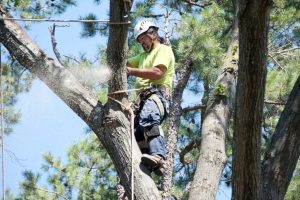Trees are beneficial to any property because they improve its value and aesthetic appeal. Having a sufficient number of trees on your property can also encourage you to spend more time outdoors.
Trees can provide countless benefits, but having ones that are leaning can do more harm than good.
Leaning trees can cause accidents and injuries, especially if your area is prone to extreme weather conditions. In addition, these trees can damage nearby properties and cause injuries to residents.
Leaning trees are a cause for concern, which is why you should act right away. Knowing how to straighten a leaning tree will give you peace of mind, knowing that your property remains safe.
Here are three ways to straighten a leaning tree:
1. Staking a Leaning Tree
Staking a tree is one of the easiest and most effective ways to straighten them. You can stake leaning trees using any soft material, like tree staking straps and canvas strapping.
Staking a leaning tree is easy and will only require a mallet or sledgehammer, garden hose, wooden or metal stakes, ropes or cables, and some protective sleeves.
Here’s how you can properly stake a leaning tree:
- Drive about three wooden or metal stakes into the ground using a mallet or sledgehammer. Cover the perimeter of the leaning tree outside of its root ball area. Make sure to position the stakes on the upwind side of the tree to anchor it against strong winds.
- Wet the area around the tree using a hose and manually push the tree straight, applying more pressure on its trunk. If you’re dealing with a huge tree, it’s best to enlist some help.
- Secure the tree to the stakes using special straps available in many online and hardware stores. You can also use a canvas hammock, rope, or cables for this process. Regardless of the material you use, avoid putting it in direct contact with the trunks because this can only damage its bark and encourage the growth of pests and diseases.
- Leave the stakes in place for at least one year. This will ensure that your tree becomes anchored as the stakes will eventually embed in the soil. Allocate time to check the stakes regularly and make adjustments whenever necessary so the tree can flex.
2. Dig a Trench
Staking a tree prevents it from leaning, but this technique isn’t usually enough, especially when you’re dealing with established and large trees. Unlike young trees, bigger trees don’t easily yield to pressure because of their thick trunks and robust root balls.
If you want to know how to keep a tree from leaning, especially large ones, you need to learn how to dig a trench into straightening it. Here’s how you can do it:
- Look for the thickest trunk of the tree using a measuring tape. This will determine how large the ditch should be. Ideally, you should dig ten inches in the ground for every inch of the tree trunk.
- Using a shovel, dig a trench at least two feet around the root ball of the tree. The goal is to free the roots from the soil to make it easier to straighten the trunk.
- Wrap the tree trunk with a thick rope and tie it securely. The other end of the rope should be tied to a car or tractor. If you have several people helping you out, then you won’t need to use a vehicle.
- Pull the rope slowly but steadily. Don’t pull the tree in one go, as this will only cause damage to the roots. Instead, pull the tree in small, slow increments.
- Once the tree is fully straight, refill the trench with soil. You can also tether the tree to the ground for a few months until its root ball anchors again in the soil.
3. Hire Professionals
While there are many DIY solutions to straightening a leaning tree, it’s still best to hire a professional tree care service to do the job. Professionals have years of experience in treating countless tree problems, which means that working with them is the most reliable way to straighten a leaning tree.
Aside from having the skills and equipment to straighten trees, these companies also provide other services to keep your trees healthy, such as our tree service.
Look for Solutions ASAP
Once you spot a leaning tree on your property, act immediately. This problem doesn’t go away on its own but only gets worse over time. Leaning trees will cause stress and expenses in the long run.
If you’ve tried several strategies to straighten leaning trees but to no avail, maximize tree care services, like the ones offered by Panorama Tree Care. We can straighten any tree and ensure that your property remains safe for decades!







